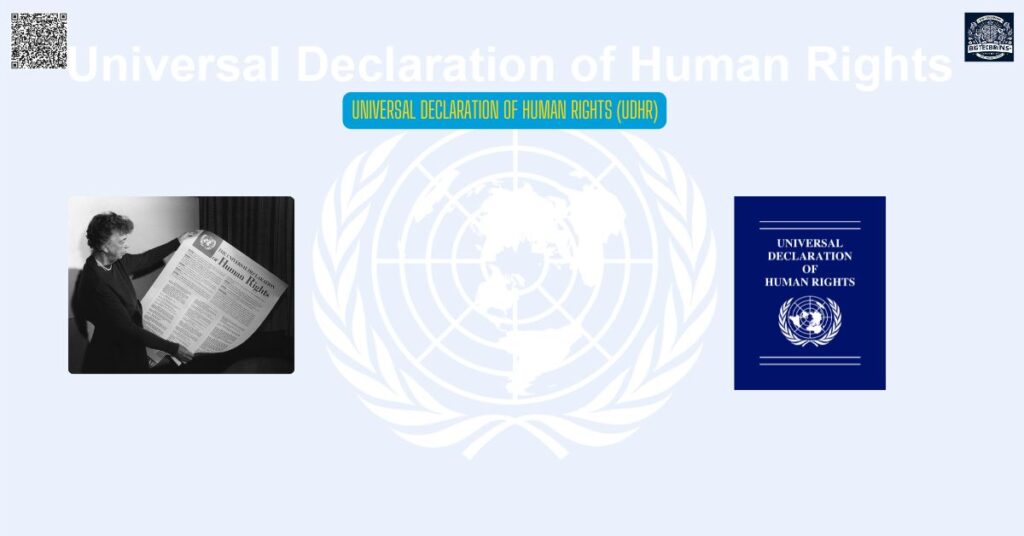Introduction
The Universal Declaration of Human Rights (UDHR), adopted in 1948, is the foundational document of modern international human rights law. Drafted in the aftermath of World War II, it proclaims the inalienable rights to which all humans are entitled, regardless of race, religion, nationality, or other status. Though not legally binding, it has inspired legally binding treaties and national constitutions, serving as a moral and political blueprint for global human rights advocacy.
Historical Context
Origins:
- Post-WWII urgency to prevent future atrocities like the Holocaust.
- Spearheaded by the United Nations Commission on Human Rights, chaired by Eleanor Roosevelt.
- Drafting involved contributions from diverse legal and cultural perspectives (e.g., René Cassin of France, Charles Malik of Lebanon, and P. C. Chang of China).
Adoption:
- Approved by the UN General Assembly on December 10, 1948, with 48 votes in favor, 8 abstentions (including the Soviet bloc, South Africa, and Saudi Arabia), and no oppositions.
Legacy:
- December 10 is celebrated annually as Human Rights Day.
Structure and Content
The UDHR consists of a preamble and 30 articles outlining fundamental rights and freedoms:
Civil and Political Rights:
- Right to life, liberty, and security (Article 3).
- Prohibition of slavery (Article 4) and torture (Article 5).
- Right to equality before the law (Article 7) and fair trial (Article 10).
- Freedom of thought, religion, and expression (Articles 18–19).
Economic, Social, and Cultural Rights:
- Right to work, education, and healthcare (Articles 23–26).
- Right to participate in cultural life (Article 27).
Collective Rights:
- Right to a social order ensuring dignity (Article 28).
- Duties to community (Article 29).
Key Principles
Universality:
- Rights apply to all people, everywhere.
Indivisibility:
- Civil,
- Political,
- economic,
- social,
- and cultural rights are interdependent.
Non-Discrimination:
- Rights must be upheld without distinction (Article 2).
Legal Status and Influence
Not a Treaty:
- he UDHR is a declaration, not legally binding. However, many provisions reflect customary international law.
Foundational Impact:
Inspired binding treaties, including:
- International Covenant on Civil and Political Rights (ICCPR).
- International Covenant on Economic, Social and Cultural Rights (ICESCR).
- Together, these form the International Bill of Human Rights.
Regional Systems:
- Influenced the European Convention on Human Rights (1950)
- and the African Charter on Human and Peoples’ Rights (1981).
Legacy and Impact
Global Advocacy:
- A reference point for NGOs (e.g., Amnesty International, Human Rights Watch) and social movements.
National Laws:
- Incorporated into constitutions (e.g., South Africa’s post-apartheid constitution).
Human Rights Education:
- Used in curricula worldwide to teach dignity and equality.
Challenges and Criticisms
Enforcement:
- Lack of binding mechanisms limits accountability.
Cultural Relativism:
- Critics argue it reflects Western values, neglecting non-Western perspectives (e.g., debates over freedom vs. communal rights).
Political Resistance:
- Authoritarian states often dismiss UDHR principles as interference in sovereignty.
Support and Enduring Relevance
Universal Aspiration:
- Praised for uniting humanity under shared values.
Adaptability:
- Framework used to address modern issues (e.g., digital privacy, climate justice).
UN Sustainable Development Goals (SDGs):
- Align with UDHR principles (e.g., ending poverty, promoting equality).
Key Quotes
Preamble:
- “Recognition of the inherent dignity and of the equal and inalienable rights of all members of the human family is the foundation of freedom, justice, and peace in the world.”
- “All human beings are born free and equal in dignity and rights.”
References
Full Text of the UDHR:
UN Human Rights Office:
- https://www.ohchr.org/en/human-rights/universal-declaration
Academic Analysis:
- Morsink, J. (1999). The Universal Declaration of Human Rights: Origins, Drafting, and Intent.
- Glendon, M. A. (2001). A World Made New: Eleanor Roosevelt and the Universal Declaration of Human Rights.
NGO Perspectives:
- https://www.amnesty.org/en/
- https://www.hrw.org/

